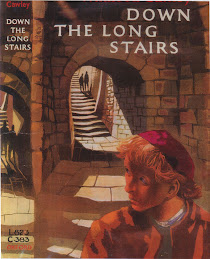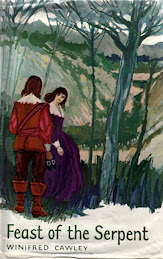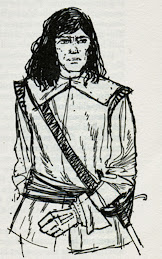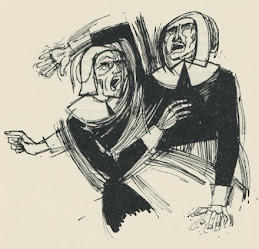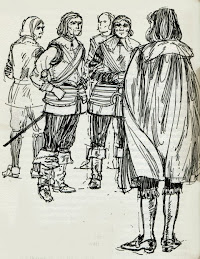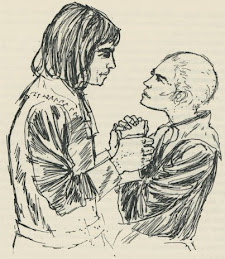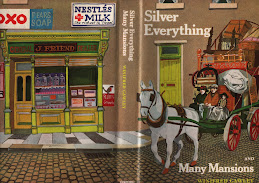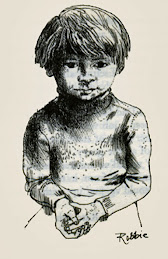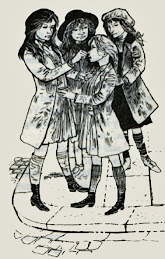Winifred Cawley was born in Felton, Northumberland in 1915.Her parents were both in service to the local gentry, and she went to local schools in Wallsend-upon-Tyne, before winning a scholarship to the University of Newcastle to read English. In 1937 she moved to University College London, to do a teaching diploma. She married Arthur Crawley in 1939. She then followed a career in teaching for the British Council in Romania, Yugoslavia and Cairo throughout World War II; and then a number of teaching jobs in Sheffield, Australia and Leeds, as she followed her husband's career with the British Council.
When in Australia she took up writing and sent her first novel, “Down the Long Stairs” (1964), to the Oxford University Press,. Her most famous work was “Gran At Coalgate”, which won the 1974 Guardian children's prize and was runner-up for the Library Association Carnegie Medal in the same year. Winifred Cawley only wrote four books but she made an interesting contribution to both the historical novel for children and to the early attempts at social realism in children’s books. She died in 2001 aged 86.
When in Australia she took up writing and sent her first novel, “Down the Long Stairs” (1964), to the Oxford University Press,. Her most famous work was “Gran At Coalgate”, which won the 1974 Guardian children's prize and was runner-up for the Library Association Carnegie Medal in the same year. Winifred Cawley only wrote four books but she made an interesting contribution to both the historical novel for children and to the early attempts at social realism in children’s books. She died in 2001 aged 86.
BOOKS FOR CHILDREN:
Down the Long Stairs 1964
The Feast of the Serpent 1969
Gran at Colgate 1974
Silver Everything and Many Mansions 1976
Winifred Cawley began to be published as a children's writer quite late in life with her first book appearing in 1964. "Down the Long Stairs" was set during the English Civil War and made use of many locations well known to the author from her youth. She followed this with "Feast of the Serpent" which continued the story of some of the characters who had appeared in her earlier novel. However, the two books form a neat contrast with each other. "Down the Long Stairs" follows the adventures of Ralph Cole from a well-off family as he runs from danger and out into the countryside. On the other hand "Feast of the Serpent" traces the adventures of Adonell Herron as she moves from a life of poverty in the countryside into the very real dangers of city of Newcastle during the infamous witch trials. Both books are a clever blend of fast-moving adventure, tender romance, and the convincing minor details of historical events
Next Winifred Cawley turned to another period in the history of the North-East of England. For her, however, the 1920s were the decade during which she was growing up and facing the demands of the somewhat grim world that then surrounded her. Strangely enough the reader meeting "Gran at Colgate" and "Silver Everything and Many Mansions" for the first time would actually be best advised to read them with the later written novel taken first. Even more remarkably, though "Gran at Coalgate" won the Guardian Prize, in this reviewer's opinion the later book (in effect the prequel to "Gran at Coalgate") is the better book. Both volumes are about the childhood of Jinny Friend (a partly autobiographical self-portrait) and life with her family in Wallsend. At the time of the stories Jinny passes between the ages of 8 and 11. "Gran at Coalgate" is largely set in Leadgate in County Durham on the eve of the General Strike of 1926.
Down the Long Stairs
"Down the Long Stairs" is set partly in Newcastle and partly in various different locations in the Northumberland countryside. The action takes place during the English Civil War where whole communities and even families could be torn apart by their different allegiances. Winifred Cawley's view of these events is almost deliberately non-partisan. Ralph Cole, the young hero, is an ardent admirer of the Royalists, whereas the elders in his family have given their support to Parliament. However, the reader rapidly comes to the conclusion that Ralph is a headstrong young fool who causes his family nothing but heart-ache and trouble.
. As can be seen during the book Ralph undergoes not just the physical journey on the run from place to place but also a voyage to maturity as he begins to realise the consequence of rash actions that are undertaken as a result of selfish pride and misplaced loyalty. Ralph may be the main character in the book, the youth whose adventures we are invited to share, but our earlier use of the word "hero" must be subjected to some qualification. Young Ralph certainly has a lot to learn and the book ends with a sad reflection upon the path that he took that led him to his changed way of life. At the age of fourteen he had everything that could ever be desired. He is the elder son in a family of "Hostmen" or coal-traders, who have a monopoly on the rich Tyne coal trade. He is pampered by the family nurse and adored by his little sister. He lives in luxury within the sound of the chimes of Newcastle Cathedral and need only go "Down the Long Stairs" of the title to reach the famous Quayside. True, his mother is about re-marry and he doesn't like the man she has chosen whose support is for Parliament. However, it takes a remarkably rash action by Ralph to throw it all away
What follows in this account is a mere glimpse at some of the action for the purpose of this website is to lead you to the books and hope that you will choose to find out the details yourself. You can still visit Tynemouth Castle today and re-create in your mind the sweep of events that turned a scornful young man into a desperate fugitive. With Winifred Cawley's narrative available you too can meet the really heroic people in the book - the ordinary people of North Tyneside who grub in the darkness for coal or who battle the sea for their meagre diet of fish. You can also meet for the fist time the remarkable Archie Reed whose true mettle is to be seen in the sequel "Feast of the Serpent". In your imagination the author can take you to visit the border reivers in Elsdon, and to watch the rebellious townsfolk of Hexham, and, finally, to be repelled by the horror of the grim cell in Newcastle's Westgate Tower.
Feast of the Serpent
When Archie Reed helped young Ralph Cole in "Down the Long Stairs" it seemed that he was just a minor character in the world of the north-east of the 1650s that Winifred Cawley set out to create. However, in "Feast of the Serpent" he is most definitely the hero whose fortune we follow with interest and sympathy. The others who helped Ralph have made great strides forward in the world because of the gratitude of the Cole family. Archie remains very much his own man, looking forward more to returning to the small country village he comes from than seizing the main chance that has been offered to him.
And yet this story is really not about Archie's heroism at all. It mainly concerns this strange world of the past seen again through the experiences of a girl who comes from the most unpromising of backgrounds. Adonell Herron is the daughter of gypsy mother and a border reiver father. When her father is taken and hanged at Carlisle Castle her mother insists that Adonell should go with her to rejoin the ancient Faa people and be initiated into their ways. Life in the mid 17th century is depicted as being harsh and brutal and there is certainly no romantic picture given of the gypsies and their ways. The ceremony which takes place near Crag Lough alongside Hadrian's Wall is both frightening and repugnant. The "tricks of the trade" that Adonell is forced to learn find no responsive echo in her heart. This is not the way of life that Adonell wants. She wonders all the time what the future may hold for her. It seems that nothing could be worse and then anything would be better. This summary of her future life proves to be a remarkable understatement. Little does she know the ordeal that she is to undergo.
We now must only mention that Archie and Adonell find that their destinies are strangely intertwined. It would be unfair to reveal any more details of their story here. The events that took place in Newcastle in 1650 are still absolutely chilling to read about and still perhaps not so well known as they deserve to be. It is a blot on the city's record that remains to this day. Most of the world has heard of the infamous Salem Witch trials; many know of the deeds of Matthew Hopkins, the notorious Witchfinder General; but few realise that the greatest mass hanging of witches in the British Isles took place on Newcastle's Town Moor in the year 1650. 14 women and 1 man were dispatched from this world because of a mixture of malevolence and superstition. Winifred Cawley gradually draws you into this world, creating horror out of the real events without any resort to fantasy. What happens to Archie and Adonell is the stuff of which nightmares are made. The evil and love to be found in human beings are weighed in the balance, and you must read this tragic story to find out on which side your judgement will finally come down.
Silver Everything and Many Mansions
There are really two books in this one volume but both are about 8 year old Jinny Friend and her life with her father, mother and younger brother on the back-streets of Wallsend on Tyne. The episodic stories contained in each half of the narrative do not conform to what is normally expected of a plot in a children's book. This is because the experiences described are strongly autobiographical. However, as each "slice of life" develops Jinny's understanding of the world she lives in, the readers can begin to consider her short journey through this part of her youth to be the storyline that they can follow.
Like Winifred Cawley's own parents, Mr.and Mrs. Friend in the story were in service with the minor gentry in Northumberland. The transition to Wallsend was to take advantage of better paid work in the famous shipyards of that town. Fluctuation of demand made this an uncertain source of employment and Mr. Friend decided to move to a more commercial district and sink his savings into a small shop. For Mr. Friend this involves the challenge of managing his own business, and for for Jinny it poses the even greater challenge of a sensitive girl fitting into a new community and starting a new school.
Jinny's little brother is at once at home in the new world. Her own struggle to adopt to the rougher manners and habits of the children who surround her makes Jinny's experience much more unpredictable and, for a while, more unpleasant. Even life at home is a constant challenge. The author presents us with many examples of the minor rules that it was so easy for a child to trangress. Her father's membership of a strict chapel means that he regards many aspects of children's behviour to be sinful rather than inevitable.
Both Jinny and her father have a lot to learn and the author is very skilful at using significant episodes to show how each comes to a better understanding of the other, and also how each learns that there is no going back to the world they knew before. Details have been deliberately suppressed in this introduction so that you may encounter these experiences for yourself.
Gran at Coalgate
In “Gran at Coalgate” (1974) the reader very quickly learns that three years have not cleared up the confusions and worries that exist in Jinnie Friend’s world (see "Silver Everything/Many Mansions"). In fact, as the eleven year old sees more of people and questions some of her automatic obedience to her father’s ideas, the world becomes even more painful to face. She also faces the extra problem of the scholarship examination which she must pass if she is going to fulfil her ambition and become a teacher. Even if she does pass there is no guarantee that her father will want to pay for the additional expense of keeping her respectably on at school. The local doctor sees the pressure Jinnie is under and prescribes that what she needs is a little holiday
The “Coalgate” of the title is in fact Leadgate in County Durham. It is obviously a place that the author remembers with a great deal of affection. Yet she chooses to place Jinnie’s holiday in the middle of two potentially disturbing events. The first is the build-up to the General Strike of 1926, which will plunge the mining industry and the whole country into a state of crisis and chaos. Much more melodramatic and unconvincing is the account of a crisis in the family in “Coalgate” brought on by the behaviour of Aunt Bella, a formidable woman, who is always referred to by the condemnatory epithet “no better than she should be”. Strictly speaking, some of the themes that are explored in this book are not ones that are really appropriate for a child to read about and struggle to understand. Jinnie’s attempts to comprehend why sin is so attractive and why family loyalty is so important are never really brought to a logical conclusion. The juvenile reader is given a full measure of the pain involved in this “slice of life” but is also left in a sort of moral vacuum at the end where many of the issues are left unresolved.
The many enjoyable facets of the book must not be left unmentioned. One of the best visions of a child’s suffering is contained in the episode where Jinnie’s father and mother come to visit on the Sunday half-way through her holiday. She knows with an excruciating certainty that her father will speak out. The Coalgate relations are committed with a sort of grim fatalism to the strike that is about to happen and Jinnie’s father is bound to tell them what they are doing wrong and how they are doomed to lose. There is also the more personal fear that Jinnie will be cast out from her father’s love for being an abominable sinner. Her crime was a visit to a cinema with her cousin Nan. Winifred Cawley recaptures very accurately that terrible fear, known so well to children, that two groups of people that they love will fall into terrible rages with each other.
Perhaps the most poignant reminder of a lost world is in the description of the journey at the beginning of the book. For the eleven year old Jinnie a train journey is rare and special. It is one that now can only be completed in our imagination. True, the small steam train pulls out of Central Station over the famous diamond crossing and then crosses on the top tier of the High Level Bridge. Later, however, it curves through Low Fell, Lamesley, Beamish, Pelton, Birtley, Annfield Plain and then Coalgate. For Jinnie it was a journey into another world, one that could not be rushed. The destination in one sense was her beloved grandmother’s house; in another it was the first stage on her journey to the harsh world of maturity, where strange and dangerous passions keep you in a constant turmoil. Unlike “Silver Everything” and “Many Mansions”, however, where the eight year old’s experiences slowly bring alive the time and the place, “Gran at Coalgate” serves up too many violent and disturbing thoughts in too short at time to retain the same plausibility. It is not surprising to find that the two books were written in non-chronological order with “Gran at Coalgate”, though dealing with later in Jinnie’s life, actually written before the other twin volume.
